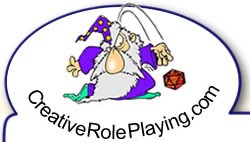Building Engaging Combat Encounters
Well-crafted encounters do more than pit your heroes against a gang of random thugs. They cause your players to think and to make the right decisions quickly. Here are the elements of combat encounters that I have found are the most effective.
- Select the right creatures for the fight
- Timing of encounter events
- Degree of movement
- Visibility
- Cover and Concealment
- Perception, Fog of War, & Confusion
- Hazards
- Traps
- Environmental Conditions
- Emotional Factors - Motivations & Fears
- Humor
Each of these factors deserve their own treatments, so you'll find links to full discussions of each combat encounter element below its brief description
Select the right creatures for the fight
Choose each creature or group of creatures in the encounter with a specific purpose or role in mind. Use monsters that are sufficiently tough to provide a challenge, but not so difficult they make the encounter a death trap.
Learn How to Select the Right Creatures for the Fight
Timing of encounter events
Every play has a script. It keeps things happening in the right sequence and provides context for what's happening on the stage. In the same way, the timing of events in an encounter keep things moving. Get the sequence of what happens right to keep the action flowing and to constantly keep your heroes on their feet.
Learn To Use Timing to Keep Things Engaging and Exciting
Degree of movement
Life happens in three dimensions. So should your combat encounters. The amount of freedom of movement or restriction of movement in these dimensions creates bottlenecks that creatures and heroes alike can use to advantage.
Learn How Restricting and Accelerating Movement Creates Strategic Challenges
Visibility
If you can't see it, it's not there, from your perspective. If you can't target a creature, you can't hit it. Limiting visibility limits potential targets. Used well, it allows events to unfold one piece at a time, especially if the players move from areas of low-visibility to ones of clear sight. In the case of moving fog or clouds, even if the players stand still, their options constantly change as targets move into and out of line of sight.
Cover
Partial or full cover simply means that even if you know a creature is there doesn't mean you can attack it from where you stand. An archer may need to maneuver to get a clear shot. Your barbarian may need to circle around obstacles to engage with back-row strikers.
Perception, Fog of War, & Confusion
In combat encounters, perception is reality. If you think an illusion is real, you'll act as if it were actually there. You may wade into strategic landmines when you don't know where an enemy is or when the attack will come. Faced with attacking one group or another, indecision or confusion sets in.
Hazards
Hazards don't prevent movement into a space, but they make it painful to do so. They are most often known dangers. Use hazards when you want players to have to make tough choices.
Traps
Traps are typically surprises. Since players typically don't know they're there. Traps slow the movement of players once one is tripped, so make sure to place traps where they make sense. If wandering down a long hallway trips a random trap, realize that players will move more carefully. This can increase the time between roleplaying or action sequences, so use random traps sparingly.
Most parties know to check a well-guarded chest for traps, so they'll expect to have to check for them in that case. However, if every time the players move, they risk springing a trap, you can be sure that the pace of exploration will likely drop to a snail's pace.
Traps are like cooking spices. Use them to add flavor. Use them too much and it spoils your creation.
Environmental Conditions
Lightning strikes at random, swaying trees prevent climbing, ice causes falls, and strong wind may knock you off your mount. These are just a few examples of environmental conditions which can hinder movement or otherwise alter the dynamics of combat.
Use environmental conditions when you want to make an encounter memorable, by changing the nature of the fight or simply by adding details about the world in which you're fighting.
Emotional Factors - Motivations & Fears
They yell out, "If you attack, the princess gets it!" This emotional factor may guide your decisions every bit as much as the monsters you face. When a villian has slipped from your grasp several times in the past, you redouble your efforts to take him down once and for all this time. Emotions drive us in real life. They also drive the most interesting characters. Give them a stage and let them play upon it.
Humor
Few things can make an encounter more memorable than humor. When the bad guy falls down a flight of stairs in the heat of combat or when a character rolls an epic fail, adding a touch of humor can add spice to any encounter.
|





